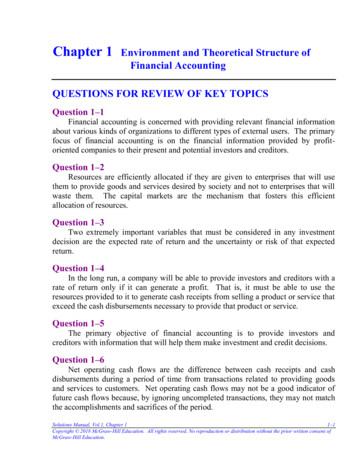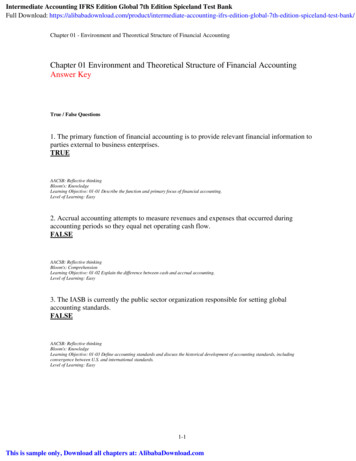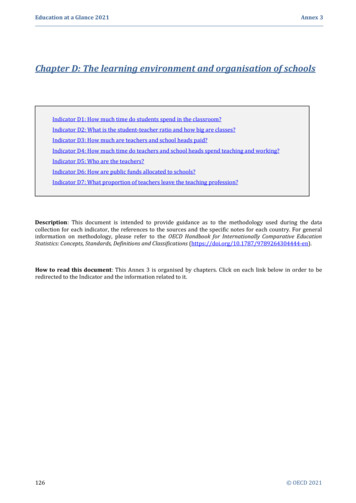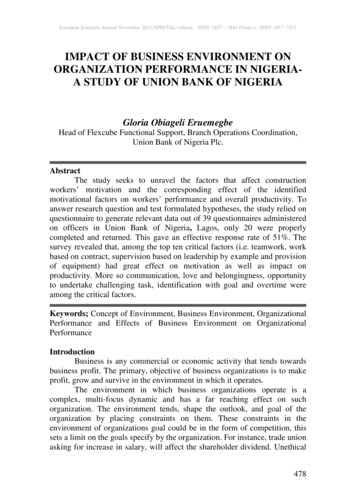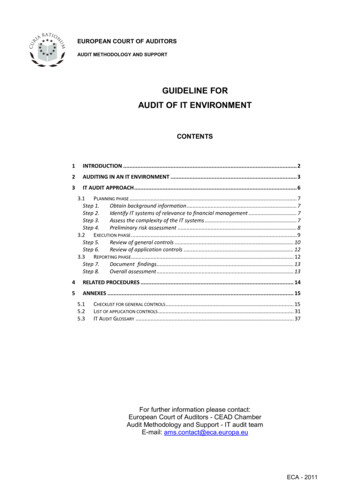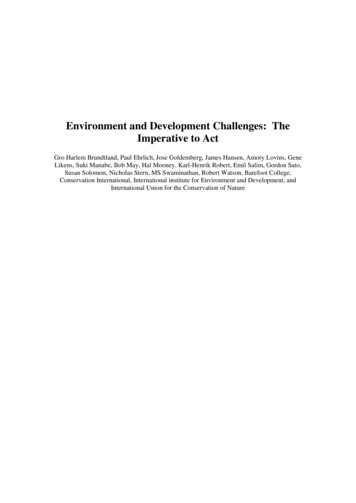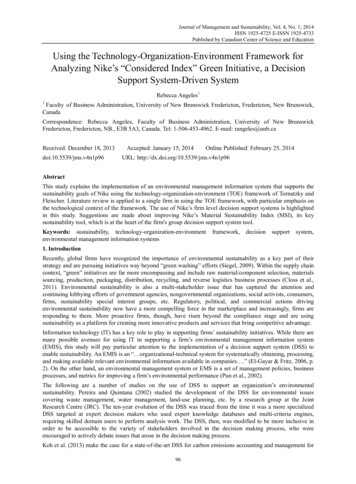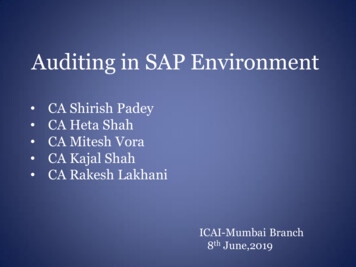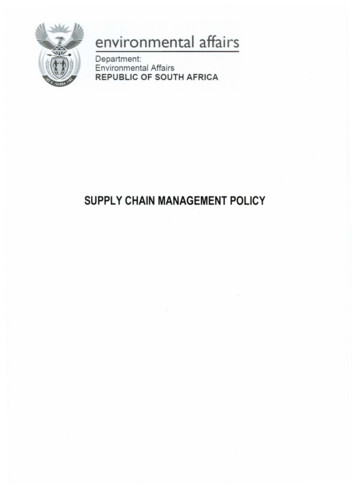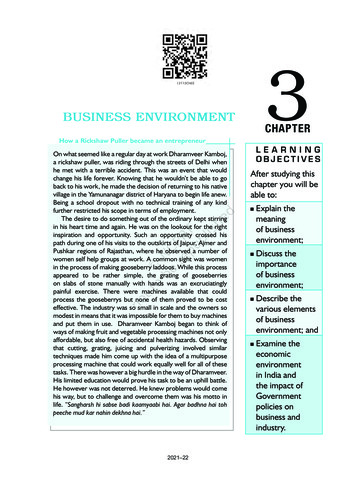
Transcription
3BUSINESS ENVIRONMENTCHAPTERHow a Rickshaw Puller became an entrepreneurOn what seemed like a regular day at work Dharamveer Kamboj,a rickshaw puller, was riding through the streets of Delhi whenhe met with a terrible accident. This was an event that wouldchange his life forever. Knowing that he wouldn’t be able to goback to his work, he made the decision of returning to his nativevillage in the Yamunanagar district of Haryana to begin life anew.Being a school dropout with no technical training of any kindfurther restricted his scope in terms of employment.The desire to do something out of the ordinary kept stirringin his heart time and again. He was on the lookout for the rightinspiration and opportunity. Such an opportunity crossed hispath during one of his visits to the outskirts of Jaipur, Ajmer andPushkar regions of Rajasthan, where he observed a number ofwomen self help groups at work. A common sight was womenin the process of making gooseberry laddoos. While this processappeared to be rather simple, the grating of gooseberrieson slabs of stone manually with hands was an excruciatinglypainful exercise. There were machines available that couldprocess the gooseberrys but none of them proved to be costeffective. The industry was so small in scale and the owners somodest in means that it was impossible for them to buy machinesand put them in use. Dharamveer Kamboj began to think ofways of making fruit and vegetable processing machines not onlyaffordable, but also free of accidental health hazards. Observingthat cutting, grating, juicing and pulverizing involved similartechniques made him come up with the idea of a multipurposeprocessing machine that could work equally well for all of thesetasks. There was however a big hurdle in the way of Dharamveer.His limited education would prove his task to be an uphill battle.He however was not deterred. He knew problems would comehis way, but to challenge and overcome them was his motto inlife. “Sangharsh hi sabse badi kaamyaabi hai. Agar badhna hai tohpeeche mud kar nahin dekhna hai.”LEARNINGOBJECTIVESAfter studying thischapter you will beable to:nnnnExplain themeaningof businessenvironment;Discuss theimportanceof businessenvironment;Describe thevarious elementsof businessenvironment; andExamine theeconomicenvironmentin India andthe impact ofGovernmentpolicies onbusiness andindustry.2021–22Ch 03.indd 6924-09-2019 12:09:28 PM
Business Studies70This is the truism that Dharamveer Singh Kamboj has alwayslived by and was able to somehow convince him and obtain afunding of 25,000 for his project. He began work immediately.The first prototype of his machine was ready in March 2005.An unexpected problem of overheating however cropped up.Even after Dharamveer’s constant trials for the elimination ofthis problem, the issue still persisted in the second prototype.But the thought of giving up never crossed Dharamveer’s mind.In his third prototype, he had successfully solved the problem ofoverheating at last. This prototype was bought by GIAN Northand sent to Kenya on a pilot basis. Based on the feedback, GIANasked him to modify it further incorporating provisions thatwould make it portable, including the incorporation of foldablelegs. In the fourth machine he also incorporated a sieve tomanage the flow of juice from the machine during the extractionprocess. The machine that Dharamveer developed is unique in away that it has the capacity to process a wide variety of productswithout damaging the seed of the fruit or vegetable.Source: The National Innovation Foundation(NIF) – India (nif.org.in)The above example shows how amachine invented by DharamveerKamboj made life easier for womenworkers in unorganised sector. Thisinnovation resulted in a positiveimpact on food processing businessi.e., social, economic and technologicalin addition to enhancing qualityof life.Meaning of BusinessEnvironmentThe term ‘business environment’means the sum total of allindividuals, institutions and otherforces that are outside the controlof a business enterprise but thatmay affect its performance. As onewriter has put it– “Just take theuniverse, subtract from it the subsetthat represents the organisation,and the remainder is environment”.Thus, the economic, social, political,technological and other forces whichoperate outside a business enterpriseare part of its environment. Soalso, the individual consumersor competing enterprises as wellas the governments, consumergroups, competitors, courts, mediaand other institutions workingoutside an enterprise constitute itsenvironment. The important point isthat these individuals, institutionsand forces are likely to influence theperformance of a business enterprisealthough they happen to existoutside its boundaries. For example,changes in government’s economic2021–22Ch 03.indd 7024-09-2019 12:09:28 PM
Business ts, political uncertainty,changes in fashions and tastesofconsumersandincreasedcompetition in the market — allinfluence the working of a businessenterprise in important ways.Increase in taxes by governmentcan make things expensive to buy.Technological improvements mayrender existing products obsolete.Political uncertainty may create fearin the minds of investors. Changesin fashions and tastes of consumersmay shift demand in the marketfrom existing products to newones. Increased competition in themarket may reduce profit marginsof firms.On the basis of the foregoingdisc ussion, it can be said businessenvironment, has the followingfeatures:(i) Totality of external forces:Business environment is thesum total of all things externalto business firms and, as such,is aggregative in nature.(ii) Specific and general forces:Business environment includesboth specific and general forces.Specific forces (such as investors,customers, competitors and supp liers) affect individual enterprisesdirectly and immediately inworking.theirday-to-dayGeneral forces (such as social,political, legal and technologicalconditions) have impact on allbusiness enterprises and thusmay affect an individual firmonly indirectly.(iii) Inter-relatedness: Differentelements or parts of businessenvironment are closely interrelated. For example, increasedlife expectancy of people andincreased awareness for healthcare have increased the demandfor many health products andservices like soft drinks, fat-freecooking oil, and health resorts.New health products andservices have, in turn, changedpeople’s life styles.(iv) Dynamic nature: Businessenvironment is dynamic in thatit keeps on changing whetherin terms of technological imp rovement, shifts in consumerpreferences or entry of newcompetition in the market.(v) Uncertainty: Business envir onment is largely uncertain as itis very difficult to predict futurehappenings, especially whenenvironment changes are takingplace too frequently as in thenologycase of information tech or fashion industries.(v i ) Complexity: Since businessenv ironmentconsistsofnumerous interrelated anddynamic conditions or forceswhich arise from differentsources, it becomes difficultto comprehend at once whatexactly constitutes a givenenvironment. In other words,environment is a complexphenomenon that is relativelyeasier to understand in partsbut difficult to grasp in its2021–22Ch 03.indd 7124-09-2019 12:09:28 PM
Business Studies72totality. For example, it maybe difficult to know the extentof the relative impact of thesocial,economic,political,technological or legal factors onchange in demand of a productin the market.(vii) Relativity: Business environmentis a relative concept since itdiffers from country to countryand even region to region.Political conditions in the USA,for instance, differ from thosein China or Pakistan. Similarly,demand for sarees may be fairlyhigh in India whereas it may bealmost non-existent in France.Importance of BusinessEnvironmentJust like human beings, businessenterprises do not exist in isolation.Each business firm is not anisland unto itself; it exists, survivesand grows within the contextof the element and forces of itsenvironment. While an individualfirm is able to do little to changeor control these forces, it hasno alternative to responding oradapting according to them. A goodunderstanding of environment bybusiness managers enables them notonly to identify and evaluate, but alsoto react to the forces external to theirfirms. The importance of businessenvironment and its understandingby managers can be appreciated if weconsider the following facts:(i) It enables the firm to identifyopportunitiesandgettingthe first mover advantage:Opportunities refer to the positiveexternal trends or changes thatwill help a firm to improve itsperformance. Environment prov ides numerous opportunities forbusiness success. Early identi fication of opportunities helps anenterprise to be the first to exploitthem instead of losing them tocompetitors. For example, MarutiUdyog became the leader in thesmall car market because it wasthe first to recognise the needfor small cars in an environmentof rising petroleum prices anda large middle class populationin India.(ii) It helps the firm to identifythreats and early warningsignals: Threats refer to theexternal environment trends andchanges that will hinder a firm’sperformance. Besides oppor tunities, environment happensto be the source of many threats.Environmental awareness canhelp managers to identify variousthreats on time and serve as anearlywarningsignal.Forexample, if an Indian firm findsthat a foreign multinational isentering the Indian market withnew substitutes, it should act asa warning signal. On the basis ofthis information, the Indianfirms can prepare themselves tomeet the threat by adopting such2021–22Ch 03.indd 7224-09-2019 12:09:28 PM
Business Environment73measures as improving thequality of the product, reducingcost of the production, engagingin aggr essive advertising, andso on.(iii) It helps in tapping usefulresources: Environment is asource of various resourcesforrunningabusiness.To engage in any type ofactivity, a business enterpriseassembles various resourcescalled inputs like finance,machines,rawmaterials,power and water, labour, etc.,from its environment includingfinanciers, government andsuppliers. They decide to providethese resources with their ownexpectations to get something inreturn from the enterprise. Thebusiness enterprise supplies theenvironment with its outputssuch as goods and services forcustomers, payment of taxes togovernment, return on financialinvestment to investors andso on. Because the enterprisedepends on the environment asa source of inputs or resourcesand as an outlet for outputs,it only makes sense that theenterprise designs policies thatallow it to get the resourcesthat it needs so that it canconvert those resources intooutputs that the environmentdesires. This can be done betterby understanding what theenvironment has to offer.(iv) It helps in coping with rapidchanges: Today’s business envir onment is getting increasinglydynamic where changes aretaking place at a fast pace. It is notthe fact of change itself that is soimportant as the pace of change.Turbulent market conditions,less brand loyalty, divisions andsub-divisions(fragmentation)of markets, more demandingcustomers, rapid changes intechnology and intense globalcompetition are just a few of theimages used to describe today’sbusiness environment. All sizesand all types of enterprises arefacing increasingly dynamicenvironment. In order to eff ectively cope with these signifi cant changes, managers mustunderstand and examine theenvironment and develop suit able courses of action.(v) It helps in assisting in planningand policy formulation: Sinceenvironment is a source ofboth opportunities and threatsfor a business enterprise, itsunderstanding and analysiscan be the basis for decidingthe future course of action(planning) or training guidelinesfor decision making (policy). Forinstance, entry of new playersin the market, which meansmore competition may make anenterprise think afresh abouthow to deal with the situation.2021–22Ch 03.indd 7324-09-2019 12:09:28 PM
Business Studies74(vi) Ithelpsinimprovingperformance: The final reasonforunderst andingbusinessenvironment relates to whether ornot it really makes a difference inthe performance of an enterprise.The answer is that it does appearto make a difference. Manystudies reveal that the future ofan enterprise is closely boundup with what is happening inthe environment. And, the enter prises that continuously monitortheir environment and adoptsuitable business practices arethe ones which not only improvetheir present performance butalso continue to succeed in themarket for a longer period.Dimensions of BusinessEnvironmentDimensions of, or the factors cons tituting the business environmentinclude economic, social, techno logical, political and legal conditionswhich are considered relevant fordecision-making and improving theperformance of an enterprise. Incontrast to the specific environment,these factors explain the generalenvironment which mostly influencesmany enterprises at the same time.However, management of everyenterprise can benefit from beingaware of these dimensions insteadof being disinterested in them.For instance, scientific researchhas discovered a technology thatmakes it possible to produce anenergy efficient light bulb that lastsat least twenty times as long as astandard bulb. Senior managersin the lighting divisions at GeneralElectric and Phillips recognised thatthis discovery had the potential tosignificantly affect their unit growthand profitability, So they havecarefully followed the progress onthis research and profitably usedits findings. A brief discussion ofthe various factors constituting thegeneral environment of business isgiven below:(i) Economic Environment: Int erest rates, inflation rates,changes in disposable incomeof people, stock market indicesand the value of rupee are someof the economic factors that canaffect management practicesin a business enterprise.Short and long term interestrates significantly affect thedemandforproductandservices. For example, in caseof construction companies andautomobile manufacturers, lowlonger-term rates are beneficialbecause they result in increasedspending by consumers forbuying homes and cars onborrowed money. Similarly, arise in the disposable incomeof people due to increase inthe gross domestic product ofa country creates increasingdemand for products. Highinflation rates generally resultin constraints on businessenterprises as they increase2021–22Ch 03.indd 7424-09-2019 12:09:28 PM
Business ironmentPoliticalEnvironmentDimensions ofBusiness Environmentthe various costs of businesssuch as the purchase of rawmaterials or machinery andpayment of wages and salariesto employees.(ii) Social Environment: The socialenvironment of business includethe social forces like customsand traditions, values, socialComponents of Economic EnvironmentnnnnnnnnnnExisting structure of the economy in terms of relative role of privateand public sectors.The rates of growth of GNP and per capita income at current andconstant pricesRates of saving and investmentVolume of imports and exports of different itemsBalance of payments and changes in foreign exchange reservesAgricultural and industrial production trendsExpansion of transportation and communication facilitiesMoney supply in the economyPublic debt (internal and external)Planned outlay in private and public sectors2021–22Ch 03.indd 7524-09-2019 12:09:28 PM
Business Studies76trends, society’s expectationsfrom business, etc. Traditionsdefine social practices thathave lasted for decades oreven centuries. For example,the celebration of Diwali, Eid,Christmas, and Guru Parvin India provides significantfinancial opportunities for gree tings card companies, sweets orconfectionerymanufacturers,tailoring outlets and many otherrelated business. Values refer toconcepts that a society holds inhigh esteem. In India, individualfreedom, social justice, equalityof opportunity and nationalintegration are examples ofmajor values cherished by allof us. In business terms, thesevalues translate into freedom ofchoice in the market, business’sresponsibilitytow ardsthesociety and non-discriminatoryemploy mentpractices.Social trends present variousopportunities and threats tobusiness enterprises. For example,the health-and-fitness trend hasbecome popular among largenumber of urban dwellers.This has created a demandfor products like organic food,gyms, bottled (mineral) waterand food supplements.innovations which provideucing goodsnew ways of prod and services and new methodsand techniques of operating abusiness. For exa mple, recenttechnological, adva nces incomputers and electro nicshave modified the ways inwhich companies advertisetheir products. It is commonnow to see computerisedinform ation kiosks, and WorldWide Web multimedia pageshighlighting the virtues ofproducts. Similarly, retailershave direct links with supplierswho replenish stocks whenneeded. Manufacturers haveflexible man ufacturing systems.Airline com panies have Internetand World Wide Web pageswhere customers can look forflight times, desti nations andfares and book their ticketsonline. In addition, cont inuinginnovations in different scientificand engineering fields such asnology,lasers, robotics, biotech foodpreservatives,medi cine,telecommunication and syntheticfuels have provided numerousopportunities and threats formanydifferententerprises.Shifts in demand from vaccumtubes to transistors, from steamlocomotives to die seland electricengines, from fou ntain pens toballpoint, from propeller airplanesto jets, and from typewriters tocomputer based word processors,(iii) Technological Environment:Technologicalenvironmentincludes forces relating toscientific improvements and2021–22Ch 03.indd 7621-11-2019 9:51:45 AM
Business Environment77have all been responsible andcreating new business.(iv) Political Environment: Politicalenvironment includes politicalconditions such as generalstability and peace in thecoun-try and specific attitudesthat elected gover nmentrepresentatives hold towardsbusiness. The significance ofpolitical conditions in businesssuccess lies in the predictabilityof business activities understable political conditions.On the other hand, there maybe uncertainty of businessactivities due to politicalunrest and threats to law andorder. Political stability, thus,builds up confidence amongbusiness people to investin the long term projects forthe growth of the economy.Political instability can shakethat confidence. Similarly,the attitudes of governmentofficials towards business mayhave either positive or negativeimpact upon business.(v) LegalEnvironment: Legalenvi ronment includes variouslations passed by thelegis Governmentadministrativeorders issued by governmentauthorities, court judgments aswell as the decisions renderedby various commissions andagencies at every level of thegovernment— centre, stateor local. It is imperative forthe management of everyenterprise to obey the lawMajor Elements of Social EnvironmentnnnnnnnnnnAttitudes towards product innovations, lifestyles, occupational distributionand consumer preferencesConcern with quality of lifeLife expectancyExpectations from the workforceShifts in the presence of women in the workforceBirth and death ratesPopulation shiftsEducational system and literacy ratesConsumption habitsComposition of family2021–22Ch 03.indd 7721-11-2019 9:51:45 AM
Business Studies78Activity IISOCIAL ENVIRONMENTContact any ten families known to you. Find out the changes in their consumptionhabits over the last five years. Analyse the impact of these changes on the workingof business enterprises.Electronic gadgets(increase in demandof these gadgets)Fashion industry(shifts towardsformal wear)Cosmetic industry(increase in demand)Food habits(shift towards packed food)Impact of shifts with the presenceof women in the workforce2021–22Ch 03.indd 7821-11-2019 9:51:50 AM
Business Environment79Indian Railway Cateringnnnnnand Tourism Corporation ltd.(A Government of India Enterprise)E-TICKET BOOKING ON THIS WEBSITE - A GUIDERegister as an individual. Registration is FREE.Login by entering your user name and password.The ‘Plan my travel and Book tickets’ page appears.Use ‘HELP’ option for any help required to book tickets.Fill in the details, by followingthe guidelines given below.Because of technological advancement, it has become possible to bookrailway tickets through Internet from home, office etc.2021–22Ch 03.indd 7921-11-2019 9:51:50 AM
Business Studies80of the land. Therefore, anadequate knowledge of rulesand regulations framed by theGovernment is a pre-requisitefor better business performance.Non-compliance of laws canland the business enterpriseinto legal problems. In India,ConstitutionalProvisions;Companies Act 2013; Industries(Development and Regulations)Act 1951; Foreign ExchangeManagement Act and theImports and Exports (Control)Act1947;FactoriesAct,1948; Trade Union Act; 1926;Workmen’s Compensation Act,1923; Industrial Disputes Act,1947, Consumer ProtectionAct, 1986, Competition Act,2002 and host of such other legalenactments as amended fromtime to time by the Parliament,is important for doing business.Impact of legal environmentcan be illustrated with the helpof government regulations toprotect consumer’s interests. Forexample, the advertisement ofalcoholic beverages is prohibited.Advertisements,includingpackets of cigarettes carry thestatutory warning ‘Cigarettesmoking is injurious to health’.Similarly, advertisements ofbaby food must necessarilyinform the potential buyer thatmothers milk is the best. Allthese regulations are requiredto be followed by advertisers.Major Elements of the Political EnvironmentnnnnnnnnnPrevailing political systemThe degree of politicisation of business and economic issuesDominant ideologies and values of major political partiesThe nature and profile of political leadership and thinking of politicalpersonalitiesThe level of political moralityPolitical institutions like the government and allied agenciesPolitical ideology and practices of the ruling partyThe extent and nature of government intervention in businessThe nature of relationship of our country with foreign countries2021–22Ch 03.indd 8025-11-2019 12:37:46 PM
Business EnvironmentEconomic EnvironmentIndia81inThe economic environment inIndia consists of various macrolevel factors related to the means ofproduction and distribution of wealthwhich have an impact on businessand industry. These include:(a) Stage of economic development ofthe country.(b) The economic structure in theform of mixed economy whichrecognises the role of both publicand private sectors.(c) Economic policies of the Govern ment, including industrial, monetary and fiscal policies.(d) Economic planning, includingfive year plans, annual budgets,and so on.(e) Economic indices, like nationalincome, distribution of income,rate and growth of GNP, percapita income, disposal personalincome, rate of savings andinvestments, value of exports andimports, balance of payments,and so on.(f) Infrastructural factors, such as,financialinstitutions,banks,modes of transportation commu nication facilities, and so on.Business enterprises in India dorealise the importance and impactof the economic environment ontheir working. Almost all annualcompany reports presented by theirchairpersons devote considerableattention to the general economicenvironment prevailing in the countryand an assessment of its impact ontheir companies.The economic environment ofbusiness in India has been steadilychanging mainly due to thegovernment policies. At the time ofIndependence:(a) The Indian economy was mainlyagricultural and rural in character;(b) About 70% of the working populationwas employed in agriculture;(c) About 85% of the population wasliving in the villages;(d) Production was carried outusing irrational, low productivitytechnology;(e) Communicable diseases werewidespread, mortality rates werehigh. These was no good publichealth system.In order to solve economic problemsof our country, the government tookseveral steps including control by theState of certain industries, centralplanning and reduced importanceof the private sector. The mainobjectives of India’s developmentplans were:(a) Initiate rapid economic growth toraise the standard of living, reduceunemployment and poverty;(b) Become self-reliant and set upa strong industrial base withemphasis on heavy and basicindustries;(c) Reduce inequalities of incomeand wealth;2021–22Ch 03.indd 8121-11-2019 9:51:50 AM
Business Studies82(d) Adopt a socialist pattern ofdevelopment — based on equalityand prevent exploitation of manby man.In accordance with the economicplanning, the government gave alead role to the public sector forinfrastructure industries whereasthe private sector was broadly giventhe responsibility of developingconsumer goods industry. At thesame time, the government imposedseveral restrictions, regulations andcontrols on the working of privatesector enterprises. India’s experiencewith economic planning has deliveredmixed results. In 1991 the economyfaced a serious foreign exchangecrisis, high government deficit and arising trend of prices despite bumpercrops.As a part of economic reforms, theGovernment of India announced anew industrial policy in July 1991.The broad features of this policywere as follows:(a) The Government reduced thenumber of industries undercompulsory licensing to six.(b) Many of the industries reservedfor the public sector under theearlier policy, were dereserved.The role of the public sector waslimited only to four industries ofstrategic importance.(c) Disinvestment was carried outin case of many public sectorindustrial enterprises.(d) Policy towards foreign capital wasliberalised. The share of foreignequity participation was increasedand in many activities 100 percent Foreign Direct Investment(FDI) was permitted.(e) Automatic permission was nowgranted for technology agree mentswith foreign companies.(f ) Foreign Investment PromotionBoard (FIPB) was set up topromote and channelise foreigninvestment in India.Appropriate measures were takento remove obstacles in the way ofgrowth and expansion of industrialunits of large industrial houses.Small-scale sector was assured allhelp and accorded due recognition.In essence, this policy hassought to liberate industry from theshackles of the licensing system(liberalisation), drastically reduce therole of the public sector (privatisation)and encourage foreign privateparticipation in India’s industrialdevelopment (globalisation).Liberalisation: The economic reformsthat were introduced were aimed atliberalising the Indian business andindustry from all unnecessary controlsand restrictions. They signalled theend of the licence-pemit-quota raj.Liberalisation of the Indian industryhas taken place with respect to:(i) abolishing licensing requirementin most of the industries excepta short list,(ii) freedom in deciding the scaleof business activities i.e., norestrictions on expansion orcontraction of business activities,(iii) removal of restrictions on themovement of goods and services,(iv) freedom in fixing the prices ofgoods services,2021–22Ch 03.indd 8224-09-2019 12:09:33 PM
Business Environment83Crisis of June 1991Major elements of the crisis situation which led the Government of India toannounce economic reform were:n A serious fiscal crisis in which the fiscal deficit reached the level of 6.6 percent of GDP in 1990-91.n Heavy internal debt which rose to about 50 per cent of GDP with interestpayments draining about 39 per cent of total revenue collections of thecentral government.n Low GNP growth rate which fell to 1.4 per cent from the peak level of 10.5per cent in 1988-89 (at 1980-81 prices).n Low overall agricultural production, foodgrain production and industrialproduction showed negative growth rates of –2.8 per cent, –5.3 per centand –0.1 per cent respectively.n Soaring inflation rate based both on wholesale price index and consumerprice index (for industrial workers) at 13-14 per cent.n Shrinkage of foreign trade, imports (in terms) fell by 19.4 per cent andexports by 1.5 per cent.n Depreciation of rupee by 26.7 per cent vis-à-vis US dollars.n Fall of foreign exchange reserves to such a low level that they werebarely adequate to meet the import requirements of a few weeks.Non-resident Indians (NRIs) were withdrawing their deposits at an alarminglyhigh rate.n The confidence of the international financial institutions was badly shakenand in just over a year its creditworthiness rating fell from AAA to BB (put on credit watch).n The country was on the verge of defaulting on international financialobligations and the situation warranted immediate policy action to savethe situation. In May 1991, the Government had to lease 20 tones of goldout of its stock to the State Bank of India to enable it to sell the gold withrepurchase option after six months. In addition, Reserve Bank of India wasallowed to pledge 47 tones of gold to the Bank of England to raise a loan of 600 million.(v) reduction in tax rates and liftingof unnecessary controls over theeconomy,(vi) simplifyingproceduresforimports and experts, and(vii) making it easier to attractforeign capital and technologyto India.Privatisation: The new set of econo mic reforms aimed at giving greaterrole to the private sector in the nationbuilding process and a reduced roleto the public sector. This was a reversalof the development strategy pursuedso far by Indian planners. To achievethis, the government redefined the2021–22Ch 03.indd 8324-09-2019 12:09:33 PM
Business Studies84role of the public sector in the NewIndustrial Policy of 1991, adoptedthe policy of planned disinvestmentsof the public sector and decidedt
of a business enterprise but that may affect its performance. As one writer has put it– “Just take the universe, subtract from it the subset that represents the organisation, and the remainder is environment”. Thus, the economic, social, political, technological and other forces whi

